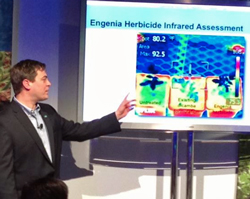 During the recent “Science Behind BASF” event, Senior Biologist Dr. Chad Brommer gave an infrared imaging demonstration to assess Engenia™ herbicide, a technologically advanced dicamba formulation developed by BASF.
During the recent “Science Behind BASF” event, Senior Biologist Dr. Chad Brommer gave an infrared imaging demonstration to assess Engenia™ herbicide, a technologically advanced dicamba formulation developed by BASF.
Chad explains that they wanted a quantitative way to measure the safety and effectiveness of Engenia. “What we see with the camera is often things we can’t see with the human eye and that’s whether the plant is physiologically functioning the same way,” Chad said. The idea is to make sure that Engenia only kills the weeds and does no harm whatsoever to the plant.
The infrared technology allows them to see whether the crop is taking up any of the dicamba through secondary loss, even if it shows no visible signs of damage, basically by taking the temperature of the plant. Comparing existing dicamba formulations with Engenia, they found about a 10 degree difference in temperature. “That doesn’t seem like much, but that’s a real indication that plant has taken up some of the dicamba through secondary loss and it’s not functioning properly,” Chad said, noting that the infrared showed no difference between the Engenia-treated and untreated control.
You might remember that we shot a little video with Chad about Engenia last year at Commodity Classic. BASF anticipates the commercial launch of Engenia herbicide in the U.S. in 2014, in a complimentary time frame with the commercialization of dicamba-tolerant soybeans. BASF expects Engenia herbicide use on cotton in 2015 following the commercialization of dicamba-tolerant cotton.
Listen to my interview with Chad here: Chad Brommer interview

